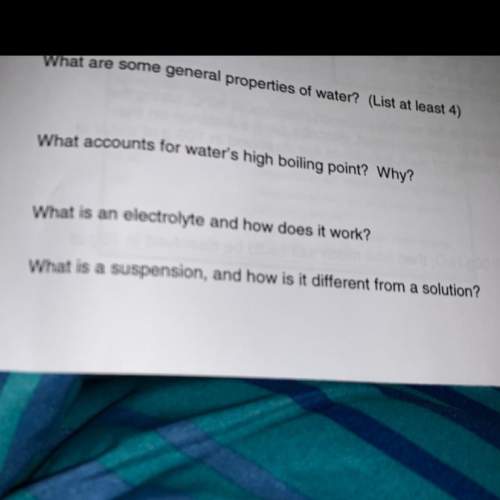
Chemistry, 20.12.2019 19:31 demigod0701
The physiological concentration of monovalent salt ions (primarily sodium, potassium, and chloride) in the human body is on the order of 0.15 molar (0.15 moles per liter or 150 moles per meter cubed). let's assume that ions only within one nanometer (1x10-9 m) of the membrane cell wall participate in creating the resting and action potentials, which is also a few hundredths of a volt but with opposite polarity (during a pulse the potential outside the axon is temporarily smaller than the potential inside the axon).
considering your answer to the previous problem, are very many of the ions transferred across the member to change the potential during a nerve pulse? and what does this tell us about the change in concentration of the salt ions near the cell wall with respect to physiological concentrations? to find if this is a small or large percentage, determine the concentration of just those ions that provide a net charge (the answer to the previous problem) yielding the resting potential within one nanometer of the cell wall. note, the volume that these charges take up will simply be the product of the area of the membrane, latex: 2\pi r\: l 2 π r l, and the one nanometer distance (10-9 m) from the cell wall that these ions/charges occupy. the charge of each ion is 1.6x10-19 c and the number of ions in a mole is 6x1023. so first find how many ions this amount of charge corresponds to, then how many moles this amount of charge corresponds to. with this, you can find the concentration of these ions within this one nanometer distance of the cell wall so that you may compare this value to physiological concentrations.
group of answer choices
a) nearly all the salt ions near the axon cell wall are involved in the passive transport across the cell wall during a nerve pulse. hence, during the pulse the concentration of the different salt ion species changes greatly before being restored to their resting potential values.
b) all the ions on either side of the axon cell wall switch sides during a nerve pulse to reverse the polarity of the cell wall.
c) only a small percentage of the salt ions near the axon cell wall are involved in the passive transport across the cell wall during a nerve pulse. hence, during the pulse the concentration of the different salt ion species doesn't change that much.

Answers: 3
Another question on Chemistry

Chemistry, 22.06.2019 11:30
Aperfume bottle is dropped in the corner of a room. the odor of the perfume can be detected on the other side of the room. which statement best describes this observation?
Answers: 2

Chemistry, 22.06.2019 18:10
Areader can tell that the meaning of “obnoxious” will include “having the quality of something” because of the .a) prefix b)pronunciation c)suffix d) word root
Answers: 3

Chemistry, 22.06.2019 20:00
Which of the following would not diffuse through the plasma membrane by means of simple diffusion? 1 oxygen 2 glucose 3 a steroid hormone 4 a lipid soluble vitamin
Answers: 3

Chemistry, 22.06.2019 21:00
Which answer tells the reason the earth’s climate is getting warmer? too many animals are becoming extinct. large glaciers are melting in antarctica. the earth is moving closer to the sun. driving cars gives off gases that trap heat in the atmosphere.
Answers: 1
You know the right answer?
The physiological concentration of monovalent salt ions (primarily sodium, potassium, and chloride)...
Questions




Chemistry, 06.12.2019 05:31

Mathematics, 06.12.2019 05:31


English, 06.12.2019 05:31

Biology, 06.12.2019 05:31

Mathematics, 06.12.2019 05:31

Mathematics, 06.12.2019 05:31

Spanish, 06.12.2019 05:31




Chemistry, 06.12.2019 05:31

Mathematics, 06.12.2019 05:31

History, 06.12.2019 05:31

Physics, 06.12.2019 05:31

History, 06.12.2019 05:31

Mathematics, 06.12.2019 05:31




